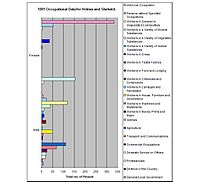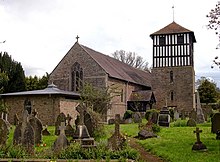Holmer And Shelwick
Population and history
In the 1870s Holmer and Shelwick was described as:
- "HOLMER, a village, a township, and a parish, in the district and county of Hereford. The village stands near the Shrewsbury and Hereford railway, 2 miles N of Hereford; and has a post office under Hereford.-The township includes Shelwick hamlet, and bears the name of Holmer and Shelwick."
Holmer and Shelwick was founded and created in 1837, however was then abolished in 1884 and became three separate parishes, these were Holmer, Holmer Within and Breinton. Holmer Within was also created out of the parish All Saints but was later abolished in 1932 and became a part of Hereford. Holmer is now what the parish of Holmer and Shelwick is known as, although Holmer and Shelwick is still used by some as the name of this small village.
In 1881, Holmer and Shelwick had a total population of 2,154, this was made up of 1,075 males and 1,079 females. The 1881 total population is a huge increase compared to 10 years earlier when there was a total population of 1,905 in 1871.

In 2001 Holmer and Shelwick had a population of 1,427 people, with 664 males and 763 females. The total number of households during this year were 523. The total population had decreased to 1,386 in 2011 according to the 2011 census. The 2011 total population was made up of 665 males and 721 females with a total of 535 households.
Age Structure
The total population of Holmer and Shelwick in the last census in 2011 was 1,386 people. Of this, the largest proportion of the total population was in the bracket of 45- to 59-year-olds with 336 people. The next largest bracket was 30- to 44-year-olds with 239 people, there are also 170 people within the bracket of 65- to 74-year-olds. This indicates that Holmer and Shelwick has a middle-aged and ageing population.
Housing
Holmer and Shelwick had a total number of 490 houses in 1881 which was an increase from 437 houses which was the total number of houses ten years earlier in 1871. However, the 2011 census shows that there has been a further increase of 45 houses to bring the 2011 total number of houses to 535.
Occupational history

The 1881 Occupational Data graph, located on the left, shows the types of occupations residents of Holmer and Shelwick had during 1881. It also shows the number of males and females working in each profession and as a result the difference in work of males and females during this time.
It shows that the majority of women in the Parish during this time were most likely unemployed, due to the largest number of women falling under the "Unknown Occupation" title. The majority of women who were employed and fell into an actual occupation category took part in very un-skilled jobs such as 'Domestic Services' with 154 women in this category, with 126 being 'Domestic Indoor Servants', or 'Workers in Dress' with 36 women in this category. However, the majority of men during this time were either working with 'General or Unspecified Commodities', with 118 men in this category, or in 'Agriculture', with 111 men in this category. 'Transport and Communications' was the next largest occupation category for men.
However, 2011 Census data can help us see how occupational trends have changed in this area over time. As stated above, census data from 1881 shows that the areas of most employment for women during that time was in 'Domestic Services' and 'Workers in Dress', in 2011 the highest employment category for women is 'Human Health and Social Work Activities', with 71 women in this category, which could be linked to 'Domestic Services', however a complete contrast to this is the second highest employment category in 2011 for women which was 'Retail Trade, Repair of Motor Vehicles and Motor Cycles', with 57 women in this category, showing how employment for women has changed over time. For men in 2011 the highest employment category is now 'Construction' with 71 men working in this sector, and the second highest employment category is 'Manufacturing' with 61 men working in this sector. This again shows the change in employment areas for men now compared to 1881.
Church of St Bartholomew

St Bartholomew's Church was built in Norman and Early English Styles with a 13th Century detached tower which was thought to be intended for defence purposes against the Welsh. The tower is topped with a black and white 16th century timber belfry with six bells, with the rest of the tower being made of stone. Some of the six bells are actually some of the oldest in Herefordshire. In 1865, three lancet windows in the chancel were decorated with rich stained glass in memory of the late Charles Bulmer, who was a local landowner in the Parish of Holmer and Shelwick. The Church of St Bartholomew is Grade I listed and has been listed since 27 January 1967, and the church also has a scheduled monument, a Churchyard Cross in the churchyard of the church.
Homer and Shelwick have a parish cemetery which contains the Commonwealth war grave of a Second World War Royal Air Force officer.
References
- ^ "Civil Parish population 2011". Retrieved 29 October 2015.
- ^ Wilson, John (1870–72). Imperial Gazetteer of England and Wales (1st ed.). Edinburgh: A. Fullarton and Co. Retrieved 12 March 2013.
- ^ "History of Hereford Registration Districts". Hereford Registration Districts. UKBMD. Retrieved 12 March 2013.
- ^ "Holmer and Shelwick (Parish): Total Population figures: Vision of Britain". Total Population. Vision of Britain. Retrieved 4 April 2013.
- ^ "Holmer and Shelwick (Parish): Key Figures for 2001 Census: Key Statistics". Neighbourhood Statistics. Office for National Statistics. Retrieved 4 April 2013.
- ^ "Holmer and Shelwick (Parish): Key Figures for 2011 Census: Key Statistics". Neighbourhood Statistics. Office for National Statistics. Retrieved 12 March 2013.
- ^ "Holmer and Shelwick (Parish): Key Figures for 2011 Census: Age Structure". Neighbourhood Statistics. Office for National Statistics. Retrieved 7 May 2013.
- ^ "Holmer and Shelwick (Parish): Total housing figures: Vision of Britain". Total Housing Figures. Vision of Britain. Retrieved 7 May 2013.
- ^ "Holmer and Shelwick Parish Council". holmershelwick.co.uk.
- ^ "Holmer and Shelwick (Parish): Occupational Data Vision of Britain". 1881 Occupational Data: Holmer and Shelwick. Vision of Britain. Retrieved 12 April 2013.
- ^ "Holmer and Shelwick (Parish): Key Figures for 2011 Census: Industry Females". Neighbourhood Statistics. Office for National Statistics. Retrieved 12 April 2013.
- ^ "Holmer and Shelwick (Parish): Key Figures for 2011 Census: Industry Males". Neighbourhood Statistics. Office for National Statistics. Retrieved 12 April 2013.
- ^ "St Bartholomew Church, Holmer and Shelwick (Parish)". St Bartholomew Church. ukattraction.com. Retrieved 12 April 2013.
- ^ "St Bartholomew Church, Holmer and Shelwick (Parish)". St Bartholomew Church. British Listed Buildings (britishlistedbuildings.co.uk). Retrieved 12 April 2013.
- ^ "CWGC casualty record".